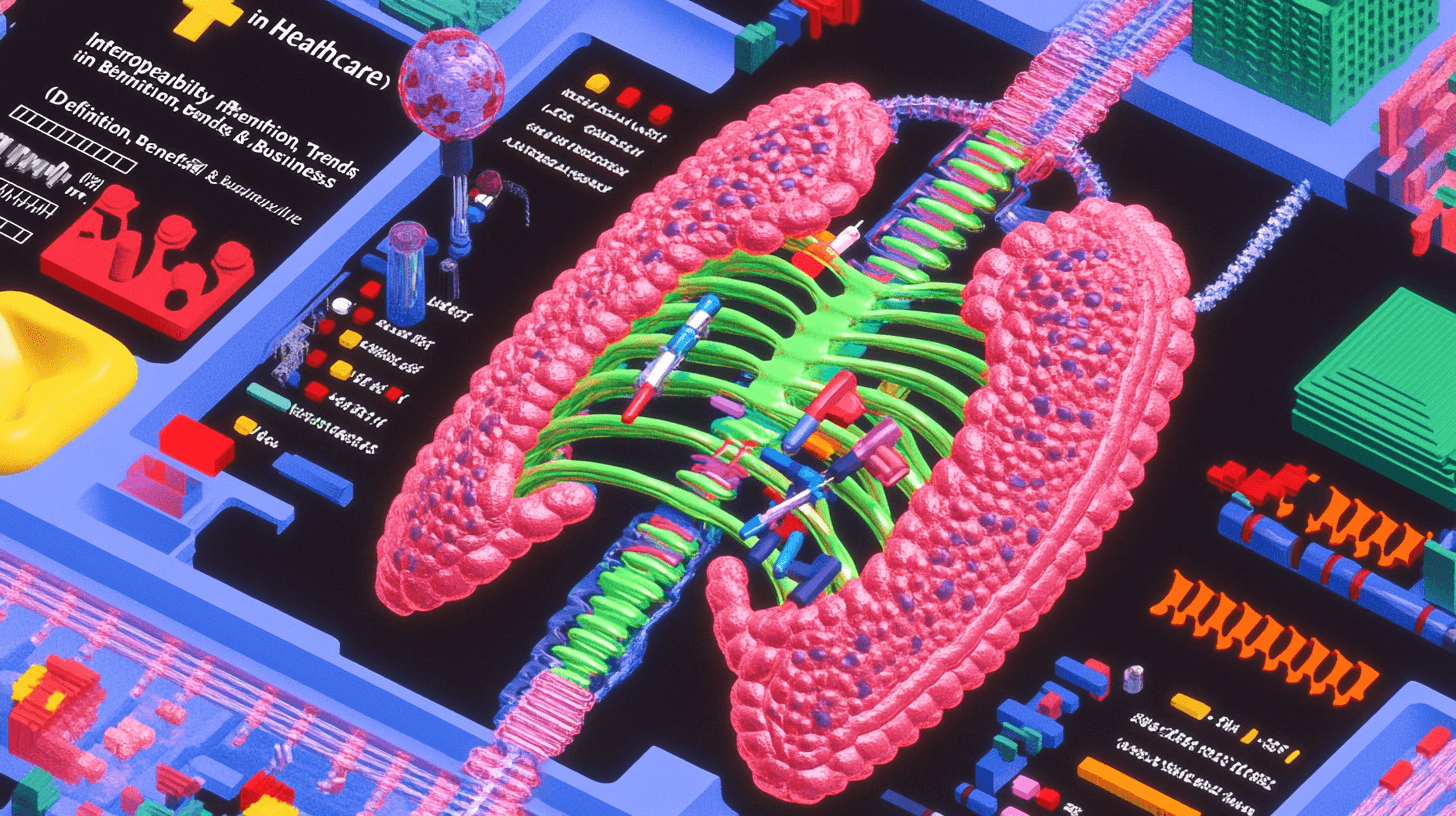Healthcare software isn’t just about building a typical app. You’re not just writing code. You’re creating tools that could shape how quickly a patient is diagnosed, how clearly a doctor sees the data, or how confidently a provider delivers care. That’s a massive responsibility — and an even bigger opportunity.
And here’s the proof: The global healthcare IT market was valued at $760.22 billion in 2024 and is projected to skyrocket to over $3.3 trillion by 2034, growing at a CAGR of 15.83%. That kind of growth doesn’t happen by accident. It’s driven by surging demand for digital health tools, from AI-enhanced diagnostics to cloud-native patient platforms and mobile-first care coordination.
In the U.S. alone, the healthcare IT market is expected to quadruple over the next decade — from $240 billion in 2024 to $1.06 trillion by 2034. North America leads with a 41% share of the global market, thanks to strong adoption of digital technologies, a robust policy framework, and influential bodies like AHIMA, AMIA, and HIMSS accelerating digital maturity.
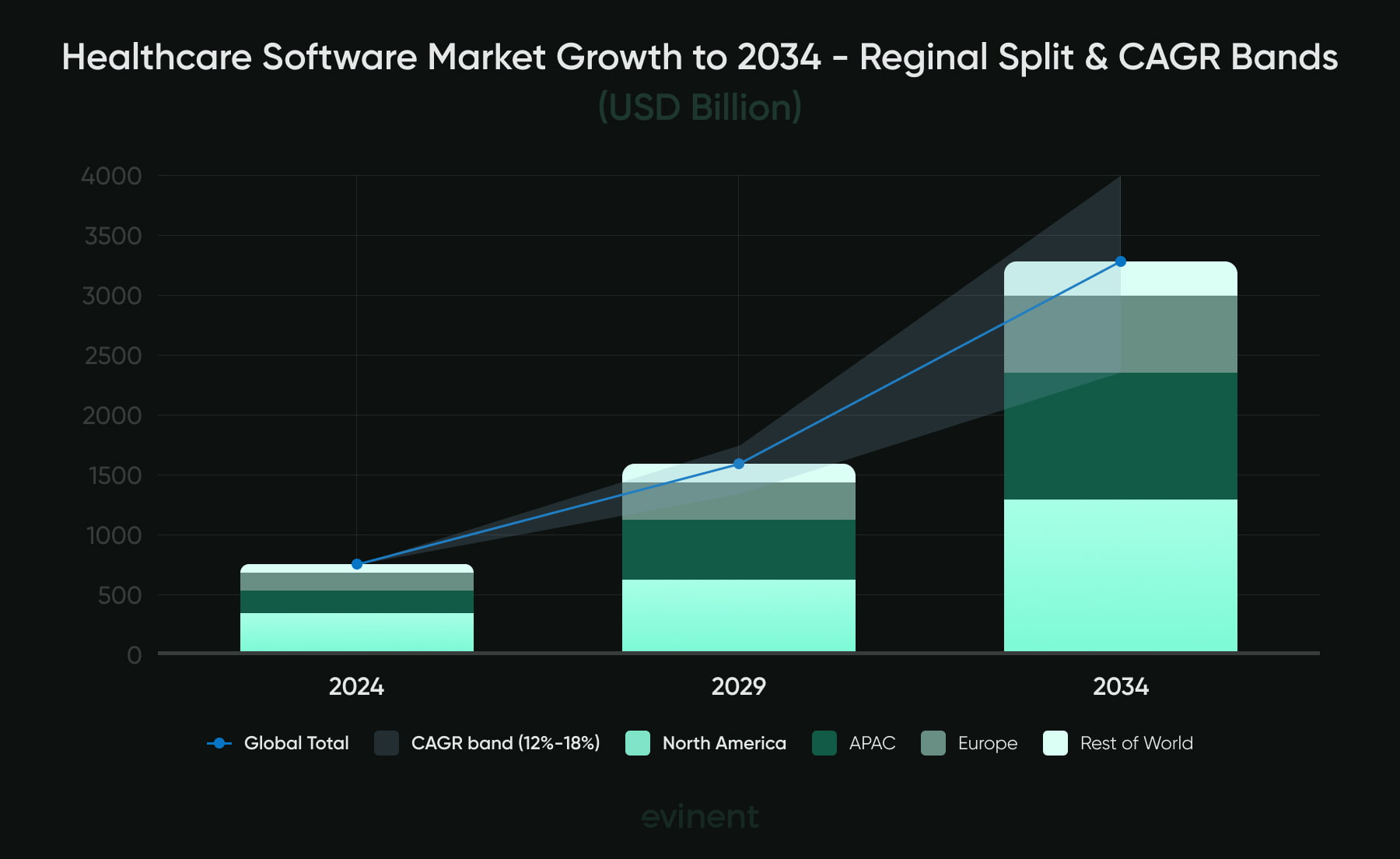
But Asia-Pacific isn’t far behind. With a rapidly growing population, smartphone adoption, and aggressive government-backed health tech initiatives, it’s the fastest-growing region in 2024, set to reshape the healthcare IT landscape in the coming years.
But building a healthcare product in 2025 isn’t just about shipping features. It’s about empathy, compliance, and precision. It’s about solving for real-world workflows, meeting strict regulatory demands, and ensuring your platform fits into an increasingly interconnected health ecosystem.
This guide is your practical blueprint. Whether you're a CTO modernizing an aging hospital platform or a startup founder validating a new digital health idea. Together we’ll walk through the essential steps, emerging trends, compliance needs, and strategic considerations that separate scalable, impactful medical tech from everything else.
Ready to get started? Let’s break it down.
What is Healthcare Software Product Development?
Healthcare software product development is the end-to-end work of building digital tools, like EHR extensions, patient portals, telehealth platforms, remote-monitoring apps, care-management systems, designed for the people who actually use them: clinicians, patients, and administrators.
Unlike general apps, medical software must do more than “work.” It has to perform with clinical precision in a regulated, high-stakes setting. That means strong data security, clear compliance with rules like HIPAA and GDPR, clean interoperability with EHRs, labs, and pharmacies, and plain-language UX that works for everyone from surgeons on night shift to older patients using a tablet for the first time (HHS HIPAA; GDPR).
This isn’t just clean code. It’s building life-enabling tools that doctors, nurses, back-office teams, and patients rely on every day, whether you’re moving MRI results across systems, automating med schedules, or opening a secure telehealth visit for someone in a rural area.
And the demand? It’s rising fast. The broader healthcare IT market was $760.22B in 2024 and is projected to top $3.3T by 2034 (15.83% CAGR), while the healthcare software-as-a-service segment alone is expected to grow ~10.5% CAGR over the same period (Precedence Research, 2024).
What’s powering the growth? A three-part push:
Tech readiness: cloud + IoT for real-time data; AI supporting radiology reads, triage, and documentation.
User pull: patients want self-service and transparency; clinicians want fewer clicks and faster context.
Policy momentum: national programs and rules that reward data exchange and safer software: e.g., ONC’s Cures Act and information-blocking rules in the U.S.; Germany’s Hospital Future Act (KHZG) funding; India’s Ayushman Bharat Digital Mission building a national health data layer.
“Hospitals are spending millions on AI tools, but if they’re not integrated into workflows and validated against real-world data, they won’t create any value.” — Rik Renard, Healthcare AI Specialist, LinkedIn (2024)
All of this makes healthcare software in 2025 a mission-critical effort in one of the most dynamic markets around. But it’s not easy. You’ll need domain fluency, a compliance-first mindset, and real user empathy through the entire lifecycle, plus a strategy that answers four questions upfront: what you’re building, who it serves, how it will grow, and how it will stay compliant.
In short: healthcare product development isn’t “just digital.” It’s people-centered innovation at scale with safety, clarity, and trust built in.
Challenges in Healthcare Software Product Development
Developing software for the healthcare industry is like performing surgery with code: it demands precision, patience, and planning. You're not just writing features — you’re working within a web of compliance rules, legacy systems, high user expectations, and tight timelines. And the stakes? They’re as real as they get. A single bug or could affect clinical decisions, patient trust, or even someone’s life.
Let’s break down the most critical challenges facing healthcare product teams in 2025:
1. Operational Complexity and Stakeholder Diversity
Hospitals and clinics are ecosystems with competing priorities. You have physicians, nurses, administrators, IT teams, compliance officers, and patients — all with different workflows and expectations. Creating a product that serves them all, without overwhelming anyone, is like walking a UX tightrope.
Stakeholder alignment is especially tough in large healthcare networks, where internal politics, budget cycles, and fragmented infrastructure can slow progress. Startups and vendors often underestimate just how many decision-makers and reviewers are involved — and how long approvals really take.
2. Tight Timelines and Compliance Pressure
Speed matters, especially when you're trying to secure funding, win early clients, or respond to a health crisis. But building fast in healthcare is risky. Every update requires documentation. Every feature needs validation. You’re working in a regulatory minefield — and there’s no shortcut through it.
This gets even trickier if your product qualifies as a medical device under FDA or MDR guidelines, where formal validation, risk assessment, and traceability are required from day one.
3. Regulatory Compliance and Data Privacy
Healthcare software lives under the shadow of regulation. Whether it’s HIPAA in the U.S., GDPR in Europe, or country-specific laws elsewhere, you’re dealing with constantly evolving requirements — and steep penalties for getting it wrong.
Cross-border compliance adds another layer of complexity. Operating across the U.S., EU, and Asia Pacific? Expect overlapping (and sometimes conflicting) privacy, access, and consent frameworks.
Even before launch, your product must be audit-ready — with detailed documentation that traces every requirement, data flow, and change log. And yes, this burden grows as you scale.
4. Data Security and Cybersecurity Risks
Few types of data are more valuable — or more vulnerable — than patient records. That makes your software a prime target for cybercriminals. A single breach could lead to lawsuits, fines, PR disasters, or worse — ed care or compromised treatment.
Things get more complex when your system integrates with third-party modules like payment processors, wearables, or scheduling tools. One weak link could expose your entire ecosystem.
Meanwhile, there's the ongoing challenge of balancing security with usability. A system that's too locked down frustrates clinicians and disrupts care. A system that's too open? Risky.
5. Interoperability and Integration
Modern healthcare is a tangle of legacy systems, proprietary EHRs, and vendor-specific tools. To succeed, your product needs to speak the language of HL7, FHIR, and other standards, while still working smoothly across outdated infrastructure.
But “integration” isn’t just a technical checkbox. It’s about ensuring data consistency across systems so clinical decisions aren’t based on missing, stale, or mismatched information. That’s a patient safety issue, not just an IT one.
Case in point: For a U.S. healthcare provider, Evinent developed a Secure Data Synchronization & Legacy Migration project. By modernizing infrastructure and building custom middleware, we enabled near real-time data aggregation and reporting across legacy systems. The result: 35% lower infrastructure costs, higher system reliability, and a scalable foundation for future analytics and AI.
This is the reality of interoperability: it’s not just about “connecting APIs.” It’s about designing systems that keep data consistent, reliable, and secure under real clinical load.
6. Rapidly Evolving Tech and Standards
New tools and standards are emerging faster than regulators can keep up. From AI diagnostics to blockchain medical records to IoT monitoring devices, innovation is outpacing the frameworks that govern them.
That creates a tough paradox: the more cutting-edge your product, the more likely you’ll face uncertainty around compliance, explainability, and ongoing support. Keeping up with ONC requirements, FDA software updates, and ethical AI standards isn’t optional — it’s survival.
Smaller companies feel this pressure most, as they scramble to meet new certification standards while staying within budget and timeline.
7. Clinical Workflow and UX Constraints
Even the smartest healthcare app will fail if it disrupts clinical workflows. Doctors and nurses already face documentation overload, shifting EHR systems, and fatigue. If your interface adds friction — or isn’t intuitive — it won’t be used.
Healthcare UX is fundamentally different from consumer UX. It’s high-pressure, time-sensitive, and safety-critical. That means minimal clicks, smart defaults, and zero ambiguity. But achieving that requires deep user research, hands-on prototyping, and real-world testing — not just design trends.
And don't forget training. If your product requires a three-day onboarding just to use basic features, adoption will stall.
8. Organizational Barriers and Resource Limitations
Larger healthcare organizations move slowly. Decision cycles are long. Budgets are tight. Legal departments are cautious. Even if you have a clear product vision, it may take months (or years) to get from demo to deployment.
Meanwhile, smaller providers may want your product but lack the technical teams or budgets to implement and maintain it. That puts extra pressure on vendors to offer plug-and-play solutions — or full implementation support.
Even internally, development teams often struggle to get clear, consistent requirements. Misaligned priorities between IT, clinical leadership, compliance, and business teams can derail progress before it starts.
9. Quality Assurance and Validation
In healthcare, bugs aren’t just annoying — they’re dangerous. QA must go beyond standard functionality testing. You need compliance testing, integration validation, performance simulation, and edge-case analysis.
You also need strong stakeholder engagement during validation. If the QA team doesn’t involve actual clinicians or admin users, you risk building something that passes tests but fails in the real world.
And don’t overlook post-release monitoring. Even after deployment, real-time feedback, incident tracking, and user behavior analysis are essential to catch issues early and iterate safely.
Healthcare software product development in 2025 is not just technically demanding — it’s high-stakes and deeply human. Success requires cross-functional alignment, an obsession with security and usability, and a proactive stance toward compliance and interoperability. The companies that get it right will help define the future of care delivery.
TL;DR
Many stakeholders have conflicting needs, including clinicians, admins, IT, compliance, patients, and different workflows, all of which require a single product.
De-risk: name decision owners (RACI), run clinical steering groups, prototype with each role.
Speed vs. regulation. Fast delivery collides with documentation and validation (FDA SaMD/MDR).
De-risk: keep a live traceability matrix, DHF/tech file from day one, sprint-level V&V checkpoints.
Privacy across regions. HIPAA, GDPR, plus local laws; audits expect data maps and consent proof.
De-risk: privacy-by-design, RBAC, BAAs/DPAs, immutable audit logs, routine DPIAs.
Security threats and third-party risk. PHI is a prime target; one weak integration can expose all.
De-risk: zero-trust, MFA/SSO, least privilege, vendor security reviews, continuous monitoring and tested IR playbooks.
Interoperability that actually works. HL7/FHIR on legacy stacks; data quality affects patient safety.
De-risk: standardize on FHIR R4/R5, code/terminology mapping (LOINC/SNOMED), interface health dashboards, identity resolution.
Tech moves faster than rules. AI/IoMT grow while standards evolve.
De-risk: adopt IEC 62304/ISO 14971 processes, AI governance (model cards, bias checks), post-market monitoring.
Clinical UX constraints. High pressure, fatigue, limited time for training.
De-risk: minimize clicks, smart defaults, role-based views, WCAG, in-clinic usability tests, short task-based training.
Org friction and resource gaps. Long approvals in big systems; limited IT in small clinics.
De-risk: offer plug-and-play integrations, clear implementation playbooks, change management, success metrics.
QA beyond “it works.” Need performance, safety, compliance, and real-world validation.
De-risk: end-to-end and integration tests, clinician UAT, load/failover drills, telemetry + fast patch pipeline.
Bottom line: Treat compliance and interoperability as everyday work, not launch gates; co-design with clinicians; measure security and usability continuously.
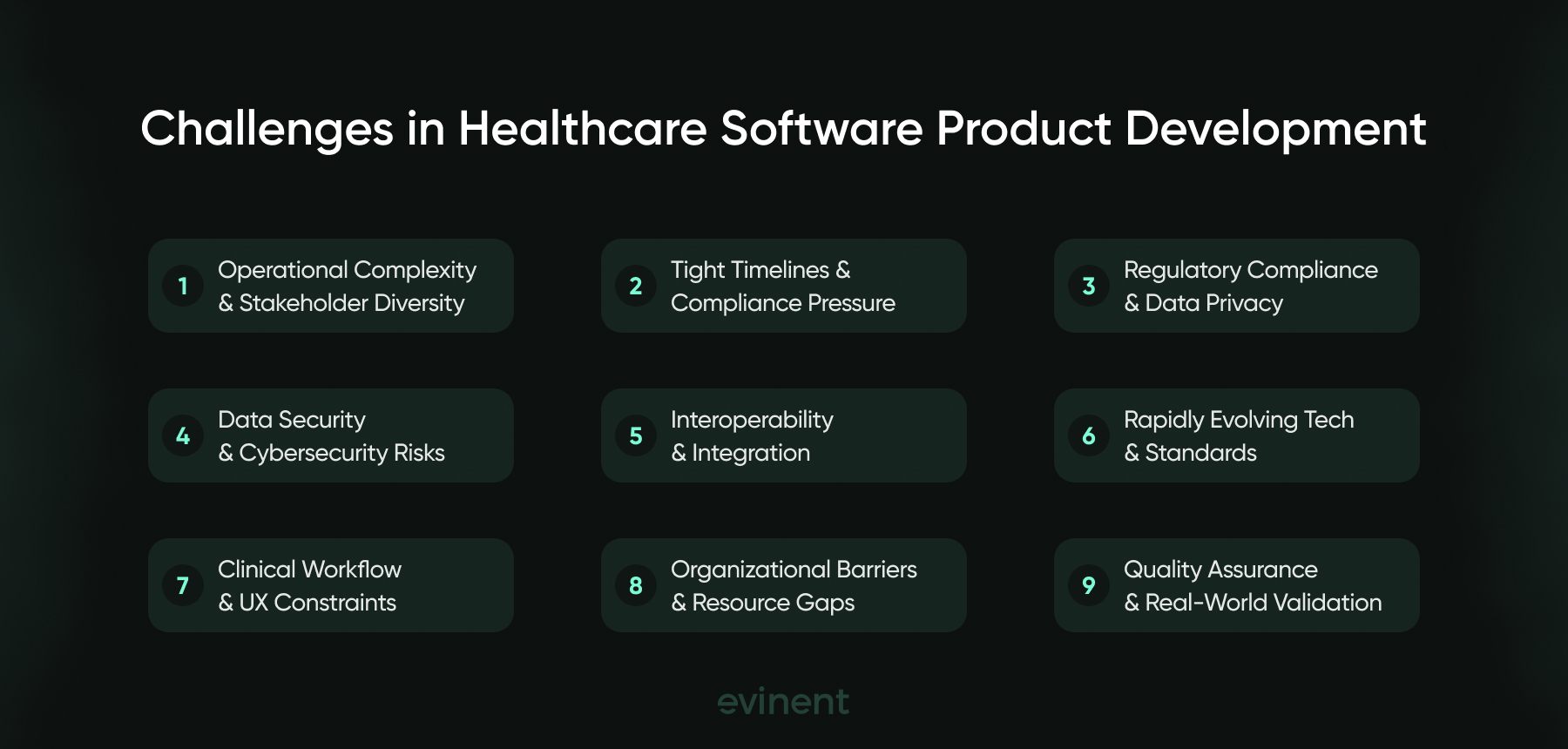
Core Features and Functional Requirements of Healthcare Software Products
To be effective, healthcare software must do more than function. It must be intuitive, secure, interoperable, and built for the long haul. It’s not just about storing data — it’s about supporting real clinical decisions, improving patient experiences, and streamlining complex operations without adding friction to already overwhelmed workflows.
In 2025, the best healthcare platforms share one common trait: they anticipate the needs of their users before they even click.
Let’s walk through the essential building blocks of modern healthcare software — from core features to must-have technical requirements.
Electronic Health Records (EHR) and EMR Capabilities
The EHR/EMR is the heartbeat of any clinical system. It’s where patient histories, diagnoses, medications, allergies, lab results, and treatment plans live.
Secure, centralized storage of patient records
Instant access across authorized care teams
Seamless integration with labs, diagnostics, and imaging tools
Searchable, versioned, and audit-ready documentation
The key is not just digitization, but also accessibility, accuracy, and continuity.
Patient-Centered UX
Whether it’s a mobile app for self-monitoring or a web dashboard for clinicians, healthcare UX must prioritize emotional safety and cognitive clarity.
Clean, responsive design for all devices
Accessible for users with visual, motor, or cognitive impairments
Designed with low-friction task flows — especially for high-stress environments
Informed by real-world user testing (not assumptions)
When patients and staff feel understood, engagement rises — and errors fall.
Appointment Scheduling & Communication Tools
Smooth appointment systems reduce admin load, improve patient satisfaction, and help reduce no-shows.
Self-service scheduling, rescheduling, and cancellations
Automated SMS/email ations and reminders
Integrated scheduling tied to EHR and provider calendars
Secure messaging for follow-ups, clarifications, and instructions
Bonus: A robust patient portal can allow patients to manage care on their own terms — with visibility and control.
Patient Management and Onboarding
From intake to discharge, managing patient information efficiently is fundamental.
Quick digital registration and intake
Secure handling of demographic data, insurance details, and prior records
Support for continuity of care across multiple visits and facilities
This reduces wait times, avoids duplication, and supports a more personalized experience.
E-Prescribing and Medication Safety
Gone are the days of paper scripts and guesswork. Today’s systems must support secure, efficient prescribing workflows.
Electronic transmission of prescriptions to pharmacies
Medication history visibility
Drug interaction s and allergy warnings
Renewal workflows and refill tracking
Integrated e-prescribing not only improves safety — it speeds up treatment delivery.
Billing, Insurance & Financial Management
Healthcare software must also handle the business side with grace and transparency.
Automated billing and invoicing
Claims submission and tracking
Co-pay and deductible management
Support for multiple payers (private and public)
Real-time financial reporting for patients and administrators
A well-designed system reduces errors, shortens payment cycles, and supports patient financial literacy.
Clinical Decision Support
Smart healthcare software should do more than display information — it should guide action.
Contextual s based on patient data and protocols
Evidence-based recommendations (e.g., drug interactions, diagnostic guidelines)
Risk scoring and predictive analytics
Dynamic dashboards for quick interpretation
These features don’t replace clinicians — but they support faster, safer decision-making.
Analytics and Regulatory Reporting
Data is powerful only when it’s actionable. Healthcare software must support real-time visibility and long-term insights.
KPI dashboards (outcomes, patient satisfaction, financial metrics)
Regulatory-compliant reports (for CMS, insurers, etc.)
Exportable data for research, audits, and quality improvement
Trend analysis to uncover gaps and inform planning
This is where clinical performance meets operational intelligence.
Real-world example: In our Healthcare Data Integration Portal project, we automated the extraction and structuring of medical chat histories from third-party APIs into a secure relational database. The portal delivered real-time transparency for clinicians and simplified compliance reporting. By aligning middleware, security, and analytics in one system, the client reduced manual work, improved efficiency, and strengthened data governance.
User Authentication and Security Controls
Security isn’t optional — it’s embedded.
Role-based access controls
Multi-factor authentication
Detailed audit logs of system activity
Secure storage and encryption of PHI (in transit and at rest)
Full alignment with HIPAA, GDPR, and other relevant regulations
The system should protect data and keep it usable — never at the cost of care delivery.
Interoperability and Integration Capabilities
Healthcare systems don’t exist in isolation. They must integrate seamlessly and reliably into wider digital ecosystems.
Support for HL7, FHIR, DICOM, and other healthcare data standards
API libraries and middleware to connect with third-party tools
Real-time sync with wearables, remote monitoring, and telehealth platforms
Custom interfaces for labs, imaging centers, and insurance systems
In short, your system should speak the same language as the rest of healthcare — automatically.
Notifications, Reminders, and s
Timely nudges improve outcomes and reduce risk.
Medication and follow-up reminders for patients
Task and schedule s for clinicians
Escalation s for abnormal vitals, missed appointments, or critical labs
Notification logs for traceability
Smart notifications reduce mental load and keep care teams responsive.
Inventory and Resource Management
Especially for hospitals and multi-site organizations, supply visibility matters.
Stock tracking for medications, equipment, and consumables
Reorder s based on usage and thresholds
Resource allocation linked to patient demand and facility needs
It’s not glamorous — but it’s critical for uninterrupted care delivery.
TL;DR
EHR/EMR as the core: secure, versioned, audit-ready, integrated with labs/imaging.
Patient-centered UX: fewer clicks, accessible, tested with real users.
Scheduling & comms: self-service, reminders, secure messaging tied to the chart.
Onboarding that sticks: clean intake, complete records across visits and sites.
eRx + safety: interactions/allergies flagged at the moment of prescribing.
Revenue ops: claims, co-pays, estimates, and clear statements without friction.
Decision support: evidence-based cues and risk scores that assist, not annoy.
Analytics & reporting: KPIs + regulator-ready outputs to drive improvement.
Security by default: RBAC/ABAC, MFA/SSO, encryption, immutable logs, HIPAA/GDPR.
Interoperability: HL7/FHIR/DICOM + vocabularies; APIs that actually scale.
Smart s: timely, traceable, minimal noise.
Ops backbone: inventory and resources aligned to real demand.
Why These Features Matter
In 2025, the healthcare software landscape is more competitive, regulated, and innovation-driven than ever before. Whether you're building for a rural clinic or a global health system, your product must do more than “work.” It has to fit into workflows, lives, and decisions.
Carefully defining and prioritizing these core features isn’t just best practice — it’s essential for compliance, performance, and patient trust.
Cost, ROI, and Development Models
Cost isn’t just about your initial budget — it’s about making strategic investments that deliver sustainable impact. In healthcare, where compliance is non-negotiable and downtime isn’t an option, financial planning must go beyond build costs. It’s about lifecycle thinking, resource alignment, and value creation across the patient-provider ecosystem.
Let’s unpack what that looks like in 2025.
Development Costs: What You’re Really Paying For
The cost of developing healthcare software can range widely — from $30,000 for a basic scheduling tool to over $500,000 for an enterprise-grade EHR platform. Here’s a snapshot of what different categories might cost:
Software Type | Cost Range | Estimated Timeline |
|---|---|---|
Basic Medical Apps (e.g., appointment booking, records lookup) | $30,000–$75,000 | 3–6 months |
Telemedicine Platforms (with video, EHR, secure chat) | $30,000–$300,000 | 8–15 months |
Custom EHR Systems | $75,000–$250,000 | 6–12 months |
Enterprise EHR for hospital networks | $500,000+ | 12–18+ months |
Medical Billing Software | $50,000–$200,000 | 4–10 months |
Hospital Management Systems | $200,000–$500,000+ | 12–24 months |
Medical Device Software | $150,000–$400,000 | 10–18 months |
Mobile Health (mHealth) Apps | Avg. $425,000 | 6–12 months |
Note: mHealth apps alone are part of a market projected to reach $88.7 billion by 2032, showing how much demand exists for well-built, user-friendly mobile solutions.
Key Cost Drivers
Several factors influence the final development price tag:
Complexity & Feature Set: AI diagnostics? Real-time video? EHR syncing? Every new capability adds backend load and compliance weight.
Tech Stack & Platforms: Native iOS + Android apps cost more than cross-platform builds. On-prem solutions demand higher upfront infrastructure investments; cloud systems trade capital for recurring operational costs.
Compliance & Security: HIPAA, GDPR, and HITRUST requirements demand detailed architecture, testing, and documentation — all of which add time and cost.
Development Location: U.S.-based builds often range from $120,000–$300,000, while skilled teams in India or Eastern Europe may offer similar outcomes for $30,000–$80,000.
Team Composition: A typical team includes developers, QA engineers, UI/UX designers, project managers, business analysts, and DevOps — and the level of experience matters.
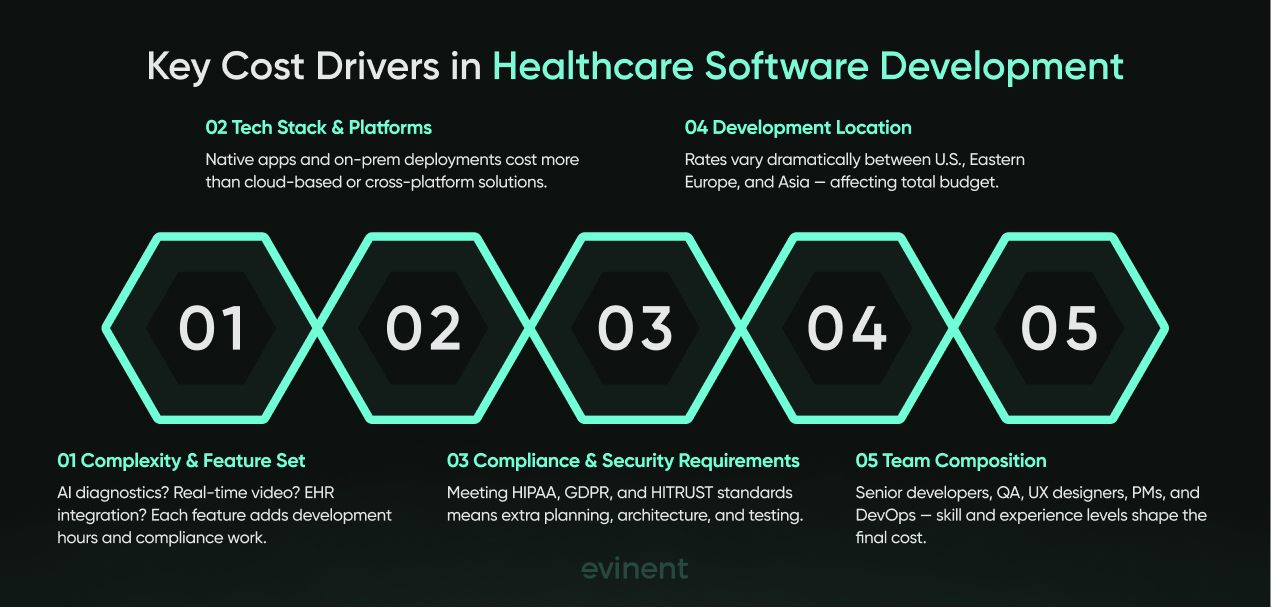
Build Smart: Custom vs. Off-the-Shelf
Custom Solutions give you control over workflows, branding, compliance, and data architecture. They’re ideal for scaling, differentiation, and integrating with legacy systems — but expect higher upfront costs and longer development cycles.
Off-the-Shelf Software gets you to market faster and cheaper — but often lacks flexibility and may require workarounds, third-party integrations, or even compromise on security.
Bottom line? If you need long-term agility, it’s usually worth investing in custom software built by a healthcare-savvy team.
In-House vs. Outsourcing
In-House Teams offer control and alignment with internal processes but come with high ongoing costs — hiring, onboarding, management, benefits, and risk.
Outsourcing, especially with a dedicated healthcare product engineering partner, reduces operational overhead and accelerates timelines — particularly if the vendor brings compliance experience and pre-validated tech stacks.
Pro Tip: Look for partners with healthcare domain knowledge, not just dev skills. Healthcare isn’t the place for trial-and-error.
Return on Investment (ROI): Where the Value Comes From
While exact ROI metrics vary, the drivers are consistent:
Improved Patient Outcomes: Better data = better decisions.
Clinician Efficiency: Automated workflows and intuitive UX reduce burnout.
Fewer Errors: Smart validation and AI-powered decision support improve accuracy.
Operational Streamlining: Billing, scheduling, claims, and inventory management become less painful.
Scalability: Well-architected systems support growth and expansion across departments or geographies.
And let’s talk market momentum:
The global healthcare software market, valued at $23.5 billion in 2023, is expected to triple by 2030, with 90% of health system executives anticipating accelerated adoption of digital technologies and more than 70% planning to prioritize operational efficiency and productivity gains. AI applications alone are expected to reduce healthcare costs by $150 billion annually by 2026 — making a strong business case for future-ready platforms today.
Development Models: Choose Your Build Approach Wisely
The methodology you follow will impact both cost and risk. In 2025, most successful healthcare projects lean on Agile or Hybrid models for flexibility and transparency.
Key considerations include:
Defined Scope & Roadmap: Before writing code, define must-have features, compliance needs, and clear business objectives.
Balanced Teams: Combine healthcare SMEs, devs, designers, and testers for a full-spectrum perspective.
Rapid Iteration: Use agile sprints for continuous feedback and faster delivery of usable features.
Validation Milestones: Regulatory-focused software must be testable, traceable, and audit-ready — with QA and compliance baked in from day one.
Keep in mind that 45% of software projects exceed their budgets and deliver 56% less value than expected, typically due to scope creep, unclear requirements, or poor communication. A detailed roadmap and stakeholder alignment from the start are your best defense.
Final Thought: TCO Over Time
Don’t fall into the trap of judging success by launch day. Consider Total Cost of Ownership (TCO) — including maintenance, support, compliance updates, scaling, and end-user training.
Great healthcare software isn’t just a one-time cost. It’s an asset — a living system that grows, adapts, and delivers value long after version 1.0 ships.
Interoperability and Integration of Software Products
In a hospital, your software isn't the only player — it’s part of a complex digital orchestra. Making it “play well with others” is non-negotiable. In 2025, interoperability isn’t just a technical feature — it’s a strategic requirement that touches everything from patient outcomes to billing accuracy.
Seamless EHR Integration
Your product must exchange data fluently with Electronic Health Records (EHRs). Standards like HL7 have been around for years, but today, FHIR APIs are leading the charge, with 90% of global health systems expected to deploy them. This modern, web-based standard makes it easier to plug into the healthcare ecosystem — whether you're integrating lab results, syncing appointments, or streaming device data.
Device and IoT Syncing
From heart-rate monitors to insulin pumps and wearable ECGs, real-time syncing with patient devices expands your platform’s utility — and your market reach. But it’s not just about collecting data. It’s about translating it into usable, structured, and secure information that clinicians can trust. That’s where FHIR, DICOM, and SNOMED CT come into play — bringing medical-grade clarity and compatibility to complex device data.
Centralized Data Hubs
In modern healthcare, data silos kill speed and accuracy. Whether it’s test results stuck in a radiology system or a med list hidden in a pharmacy app, fragmented systems treatment and create clinical blind spots. Today’s best healthcare platforms serve as clean, centralized data hubs, harmonizing inputs from multiple sources and presenting them in intuitive, real-time dashboards.
Why It All Matters
For Patients: No more repeating test results or filling out the same form five times. Interoperability brings faster, safer, more personalized care.
For Clinicians: Integrated systems reduce errors, surface key info faster, and free up time for actual care.
For Admins: Automated referrals, claims, and billing workflows improve efficiency and cut costs.
For Compliance Teams: Meeting HIPAA, GDPR, and local data-sharing mandates is easier when systems are built on standardized, auditable protocols.
But It's Not Always Smooth
Despite the benefits, integration is rarely a plug-and-play process. Many hospitals still operate systems built a decade ago — more than 50% of facilities use at least one legacy system — and these often don’t integrate well with modern cloud or API-first solutions. Other common issues include:
Inconsistent data semantics (think: one system calls it “HR,” another calls it “Pulse”)
Costly, fragile one-off integrations
Compliance tradeoffs between access and security
Localized FHIR/HL7 customizations that create “integration drift”
Best Practices
To build future-proof, connected healthcare systems, here’s what works:
Use standardized APIs and data models (FHIR, HL7, DICOM, LOINC, SNOMED CT)
Adopt cloud-based platforms for easier scaling, uptime, and integration
Employ AI-powered data harmonization tools to clean, translate, and align data across sources
Invest in data governance policies from day one — structure, semantics, access controls
Partner with experienced integration vendors who understand both healthcare constraints and real-time systems
Global Progress
Countries like Estonia (99.1% interoperability) and Finland (98.9%) are setting the bar, with nearly universal data sharing across systems, thanks to national infrastructure, open APIs, and strong regulatory frameworks.
Even vendors are catching on. Platforms in the UK/EU now report reduced onboarding time and fewer lab data errors, showing how integration pays off both clinically and commercially.
In 2025, interoperability isn’t optional. It’s the connective tissue between innovation and real-world impact. If your product can’t plug in, it won’t scale — or survive.
TL;DR
Interoperability is strategy, not plumbing. It drives safer care, faster throughput, cleaner billing, and easier audits.
EHR integration = FHIR-first. HL7 isn’t gone, but FHIR/SMART APIs are the connective tissue; most health systems are deploying them.
Devices need structure. RPM/wearables are useful only when data lands as FHIR Observations, images via DICOM/DICOMweb, and concepts mapped to SNOMED/LOINC/RxNorm.
Centralized data hubs beat silos. Normalize, map, and route data into real-time dashboards and analytics while preserving provenance.
Expect friction. Legacy systems (>50% of sites use at least one) cause semantic drift, brittle interfaces, and security tradeoffs.
2025 playbook. Standard APIs, cloud-native integration, AI data harmonization, strong governance (structure/semantics/access), and experienced partners.
Bottom line: If your product can’t plug in and stay consistent, it won’t scale or survive.
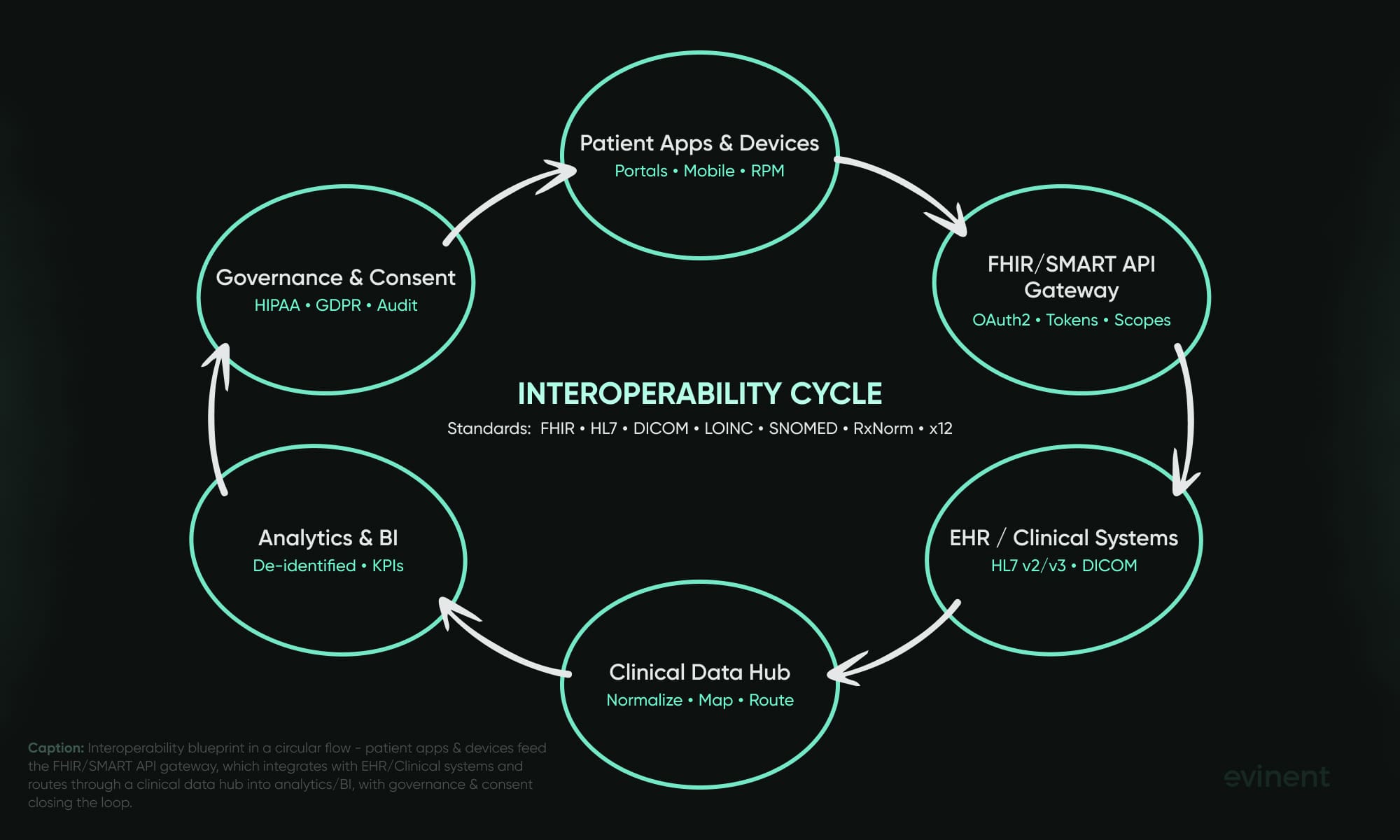
9 Key Steps in Healthcare Software Product Development
Each step in the product journey carries its own risks and rewards — and in healthcare, the stakes are even higher. From patient privacy to clinical workflow disruption, cutting corners isn't just expensive — it can be dangerous. Here’s a structured, modern roadmap to building compliant, usable, and effective healthcare software in 2025.
Great healthcare products don’t start with code — they start with context. h3
Problem Identification: Pinpoint a specific healthcare challenge or inefficiency. Is it scheduling bottlenecks? Medication mismanagement? Integration headaches?
Stakeholder Interviews: Talk to real users — clinicians, administrators, IT teams, even patients — to uncover daily pain points and unmet needs.
Market Research: Examine competitors and adjacent solutions to identify gaps, saturation points, or innovation whitespace.
Feasibility Study: Assess whether the idea is financially viable and technically buildable — especially under healthcare's heavy regulatory burden.
2. Requirements Definition and Prototyping
Compliance isn’t a checkbox — it’s a core design constraint from day one.
Framework Alignment: Identify and understand applicable regulations like HIPAA, GDPR, HITECH, and local equivalents.
Privacy-by-Design Planning: Map where personal health data (PHI) flows, who accesses it, and how it’s stored. Start encryption, consent, and logging plans early.
3. Agile Development and QA
You’re not just building features — you’re designing behaviors and outcomes.
Functional Requirements: Prioritize what the software must do — e.g., EHR integration, appointment scheduling, secure messaging, or analytics.
Non-Functional Requirements: Define system performance, uptime, scalability, usability, and security needs.
Interoperability Standards: Bake in FHIR, HL7, DICOM, LOINC, or SNOMED CT requirements early if integration is expected.
4. Launch and User Training
Vision without execution is just theory. A clear roadmap sets expectations and enables iteration.
MVP Definition: Select the smallest possible version of your product that can still deliver clinical or operational value.
Timeline and Milestones: Create a development schedule with clear deliverables, sprint cycles, and risk buffers.
Team Assembly: Bring together developers, QA engineers, project managers, UI/UX designers, security experts, and healthcare domain specialists.
5. Post-Launch Support and Optimization
A healthcare UI isn’t just about beauty — it’s about clarity, speed, and reducing cognitive overload.
User-Centered Wireframes: Design flows based on actual user roles — physicians, nurses, schedulers, etc.
Accessibility First: Ensure interfaces are usable for individuals with impairments and work across desktop and mobile.
Prototype Testing: Test wireframes and clickable prototypes with real users before committing to development.
Security Reviews: Even at the design stage, validate that proposed flows meet compliance and access control requirements.
6. Agile Development and Integration
Use iterative builds to reduce risk and gain early feedback.
Modular Development: Build key modules (e.g., login, EHR sync, appointment engine) as separate components for easier testing and maintenance.
API-Driven Integrations: Leverage HL7 and FHIR APIs to integrate labs, billing systems, pharmacy records, and wearables.
Security-First Codebase: Apply secure coding practices, especially for authentication, role management, and data handling.
7. Rigorous Testing and Quality Assurance
Healthcare software can’t afford bugs. Test for performance, compliance, and real-world reliability.
Multilevel QA: Include unit tests, integration testing, system testing, and regression testing.
User Acceptance Testing (UAT): Run simulations with clinical staff and admins to verify that workflows support real-life tasks.
Security & Compliance Testing: Perform vulnerability scans, penetration testing, and audit logging validation.
8. Deployment and User Training
Rolling out software in healthcare means balancing speed with safety.
Staggered Rollout: Start with a pilot program or a limited department, then gradually scale based on real-world results.
Role-Based Training Programs: Deliver hands-on training tailored to different users — front-desk staff, nurses, doctors, IT admins.
Go-Live Support: Provide on-call assistance during early use to troubleshoot bugs, answer questions, and guide adoption.
9. Post-Launch Support, Updates, and Compliance Monitoring
The real work begins after release.
Bug Fixes and Patches: Prioritize early feedback and critical bug fixes immediately post-launch.
Continuous Compliance Checks: Monitor regulatory updates and verify that your software remains aligned.
User Feedback Loops: Create mechanisms for gathering feedback, tracking usage metrics, and identifying upgrade opportunities.
Performance Monitoring: Use analytics and error tracking tools to measure uptime, speed, and data flow integrity.
Summary Table: Healthcare Software Development Steps
Healthcare software product development in 2025 is a highly orchestrated effort that requires cross-functional collaboration, deep domain expertise, and rigorous compliance discipline. Teams that invest upfront in validation, security, and user experience are the ones that end up building software that not only functions but also makes a real impact.
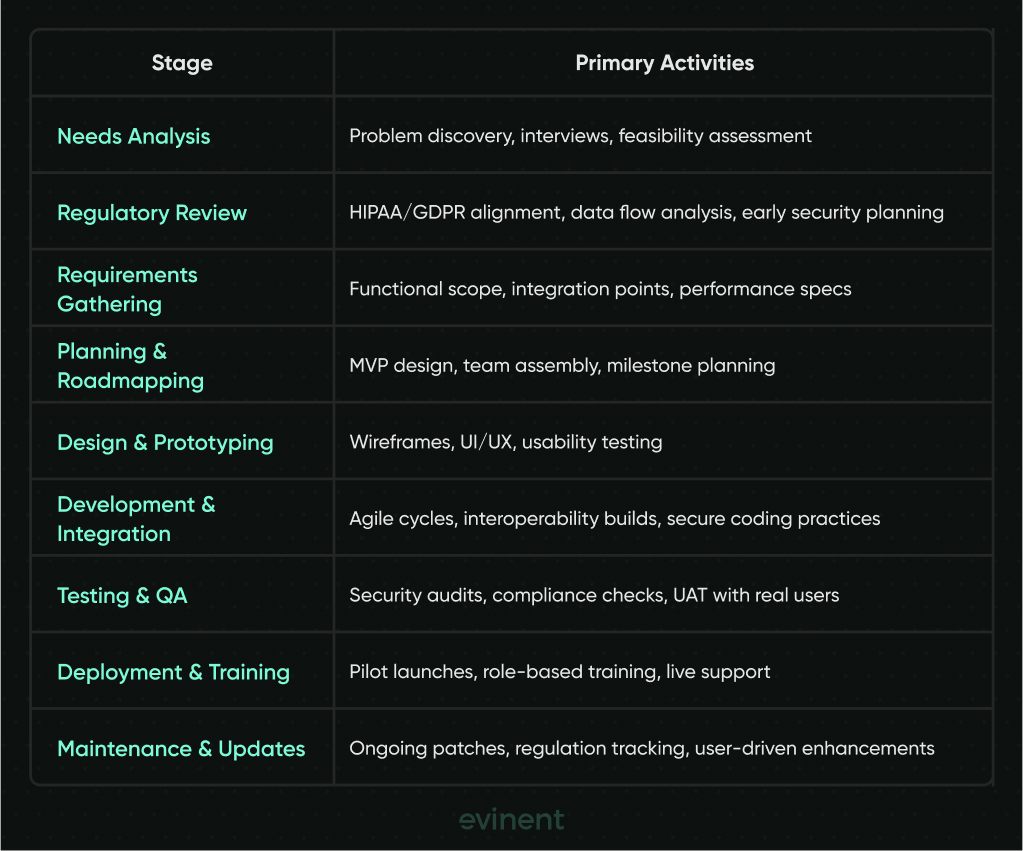
Regulatory Compliance and Security
Regulatory missteps in healthcare aren’t just costly — they can be catastrophic. One breach, one oversight, one unpatched vulnerability, and you’re risking patient safety, legal fallout, and years of earned trust. In 2025, secure software isn’t just a competitive edge — it’s a non-negotiable foundation.
HIPAA, GDPR, and Local Laws: Non-Optional Blueprints
Whether you’re operating in the U.S., EU, or globally, you’re playing by strict rules:
HIPAA (U.S.): Requires administrative, physical, and technical safeguards for protecting PHI (Protected Health Information). Think access logging, breach notifications, and encryption policies baked into the workflow.
GDPR (EU): Focuses on consent, user rights, and data minimization. Any EU-resident data stored, processed, or even touched by your software must meet these standards.
Global Compliance: Local frameworks like PIPEDA (Canada), PDPA (Singapore), and other country/state-level regulations add another layer of complexity — especially for cross-border software.
Building for compliance from day one means fewer rewrites, fewer audits, and far less firefighting later.
Security Must-Haves (No More Excuses)
When it comes to healthcare data, “good enough” security isn’t good enough. Here’s what’s expected — not optional — in 2025:
- Data Encryption:
At rest: Encrypt all sensitive information using robust algorithms (e.g., AES-256).
In transit: Use TLS/SSL for every single data exchange — across systems, devices, and APIs.
Role-Based Access Control (RBAC):
Limit data visibility based on user roles, including clinicians, administrators, and patients. No shared logins. No blanket permissions.Audit Trails and Logging:
Track everything — logins, record changes, permission updates. These logs help detect breaches and are mandatory for compliance audits.Multi-Factor Authentication (MFA):
Strong user identity controls are a must, especially for anyone handling or viewing PHI.Secure Defaults and Least Privilege:
Build systems to deny by default, not allow by accident. Only give access where it’s truly needed.
Compliance is a Lifecycle, Not a Milestone
Too many teams treat compliance like a pre-launch hurdle. In reality, it needs to live across your entire development lifecycle:You’re not just building software — you’re building audit-ready systems.
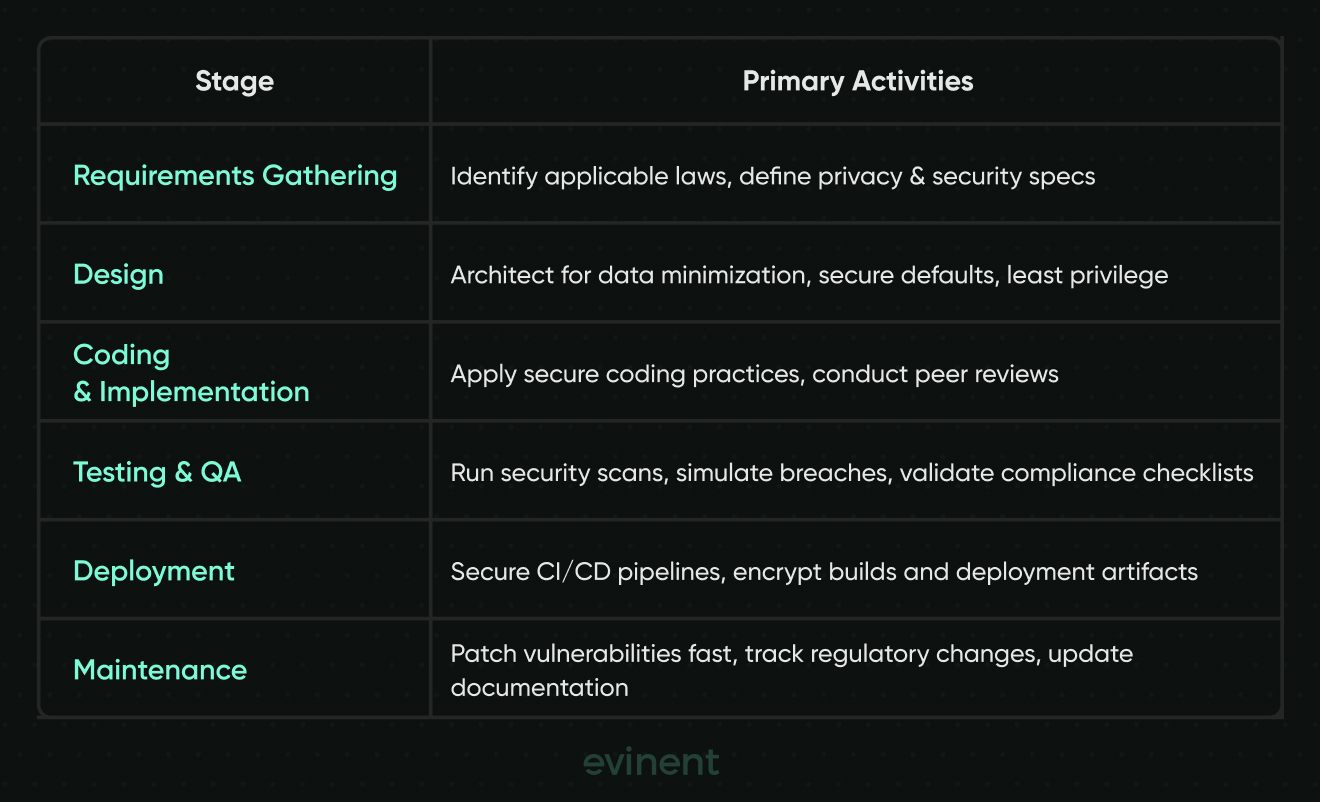
Current Challenges
It’s harder than ever to stay ahead. Here’s why:
Multi-Jurisdictional Complexity:
What’s compliant in Germany might not fly in the U.S. Add in emerging markets, and you’ve got a maze of conflicting rules.
Rising Threats:
Healthcare is one of the most targeted industries for ransomware, phishing, and insider attacks. It’s not if — it’s when.
Legacy Tech Drag:
Integrating modern security into outdated hospital systems is like fitting a jet engine onto a tricycle.
Regulation Overload:
New standards (like zero-trust mandates or FDA software oversight) require constant attention and sometimes complete architectural changes.
What Smart Teams Are Doing Instead
Forward-looking healthcare software teams aren’t scrambling — they’re building resilience into the system:
Privacy-by-Design:
Compliance isn’t retrofitted — it’s built into data flows, storage models, and UX choices from day one.
Automated Compliance Monitoring:
Real-time tools now flag misconfigurations, expired certificates, or policy drift — before they become breaches.
AI-Driven Threat Detection:
Algorithms watch traffic, detect anomalies, and on suspicious behavior faster than any human could.
Zero Trust Architecture:
Trust nothing, verify everything — especially in hybrid cloud environments or multi-device scenarios.
Vendor & API Risk Management:
Every third-party integration is a potential backdoor. Vet thoroughly, contractually bind security SLAs, and monitor continuously.
Regulatory compliance is not a one-time checklist — it’s a continuous discipline woven into your people, processes, and platform. And in healthcare, where lives are on the line, security is your product. If you build with integrity, transparency, and foresight, you won’t just stay compliant — you’ll build patient and partner trust that lasts.
TL;DR
Non-optional rulebook: Build to HIPAA (safeguards, breach notice), GDPR (consent, data rights, minimization), plus local laws (e.g., PIPEDA, PDPA). Design for cross-border variance from day one.
Security must-haves:
Encrypt PHI at rest (e.g., AES-256) and in transit (TLS).
RBAC/least privilege with no shared accounts.
MFA/SSO for privileged and clinical roles.
Immutable audit logs for access/changes/permissions.
Secure defaults deny by default, explicit grants only.
Compliance is a lifecycle: requirements → secure design → secure coding/reviews → security testing (scans, pen tests) → hardened CI/CD and signed builds → fast patching & doc updates.
2025 realities: multi-jurisdiction complexity, rising ransomware/phishing, legacy system friction, and evolving mandates (zero-trust, SaMD oversight).
What winning teams do: privacy-by-design; automated compliance monitoring; AI-driven anomaly detection; zero-trust across hybrid cloud; rigorous vendor/API risk management with enforceable SLAs.
Bottom line: Treat security as the product. Build audit-ready systems that protect patients, reduce legal risk, and earn long-term trust.
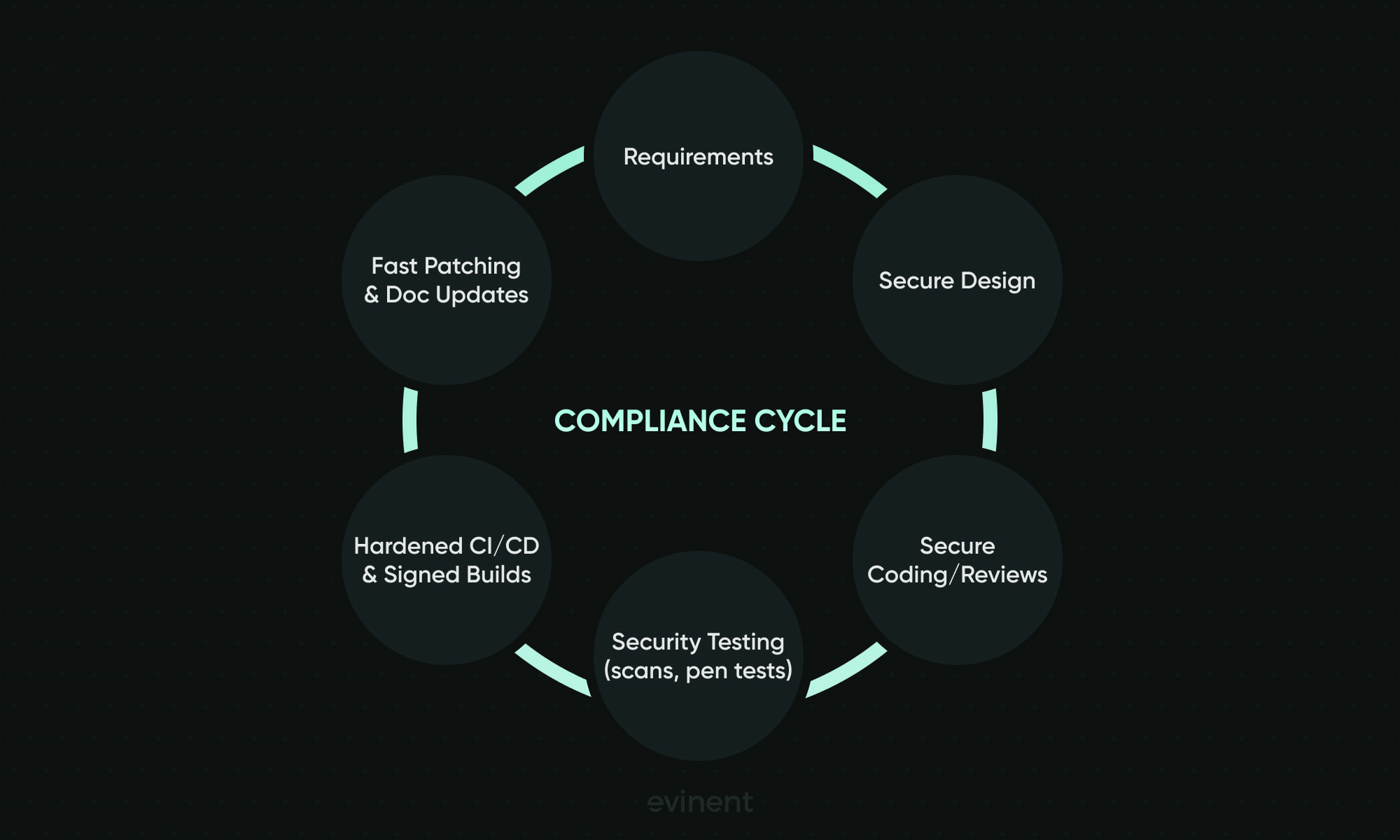
Support, Maintenance, and Scaling
Software in production isn’t static — it’s a living system that must evolve. In healthcare, where downtime disrupts care and slow performance can critical decisions, support, maintenance, and scaling aren’t back-office tasks — they’re mission-critical.
Reliable Maintenance
Bugs, vulnerabilities, and performance issues don’t wait for a convenient time. That’s why proactive maintenance is the baseline, not a bonus.
Corrective fixes should be fast and traceable. A single malfunctioning module — say, in e-prescribing — can trigger cascading issues.
Preventative upkeep (like refactoring, updating libraries, or database optimization) avoids tech debt before it bites.
Adaptive maintenance keeps your app compliant as HIPAA, GDPR, or FDA requirements shift.
Perfective enhancements evolve the software to meet user feedback and keep pace with real-world needs.
Automated monitoring, patch management, and continuous compliance audits help ensure your platform stays stable, secure, and future-ready — even when things change fast.
Responsive Support
Healthcare software support isn’t just a chatbot and a ticketing system. It’s a multi-layered safety net that helps users continue working and patients receive ongoing care.
24/7 Helpdesk: Especially for EHRs, hospital management systems, or anything patient-facing.
Clear SLAs: Response time targets that reflect clinical urgency, not generic business hours.
User Training & Documentation: Rolling out updates? Launching new features? Make sure users can actually use them.
Change Management: Communicate what’s changing, why, and how it affects end users to avoid confusion and resistance.
Regulatory Guidance: When a new rule drops, your software — and your support team — should be ready with updates and documentation.
Adaptive Scaling
Healthcare systems don’t stand still — and neither should your infrastructure. Whether you're onboarding a new hospital group or adding thousands of wearable devices, your platform needs to grow without grinding to a halt.
Cloud-Native Infrastructure: Scale compute and storage on demand using AWS, Azure, or Google Cloud.
Modular Design: Break your app into microservices so you can scale features like telehealth or analytics independently.
API-Driven Expansion: Standards like FHIR and HL7 make it easy to plug in new tools, from pharmacies to diagnostic labs to AI assistants.
Load Balancing & Redundancy: Maintain speed and uptime, even under peak loads or if something breaks.
Multi-Tenancy: Roll out your solution to multiple clinics or regions without compromising data security or compliance.
Bonus: With DevSecOps pipelines and automated testing in place, you can scale and ship confidently, without introducing regression bugs.
Continuous Optimization
Once you launch, the real work starts. Modern healthcare software is expected to adapt constantly to new users, workflows, and care delivery models.
Real-Time Monitoring: Track how your system performs under load, and how users actually use it.
A/B Testing: Experiment with new features or UX tweaks — and measure what moves the needle.
Usage Analytics & Feedback Loops: Collect input from clinicians, patients, and admins to prioritize improvements that matter.
In 2025, leading platforms use AI-enhanced monitoring to detect performance bottlenecks before users do, and auto-tune systems accordingly.
Summary Table: Support, Maintenance & Scaling
The healthcare world moves fast, and expects your product to keep up. Support, maintenance, and scaling aren’t afterthoughts. They’re the invisible backbone of user trust, operational continuity, and long-term product success. If your app can't evolve, it won’t survive. But if it can? It becomes indispensable.
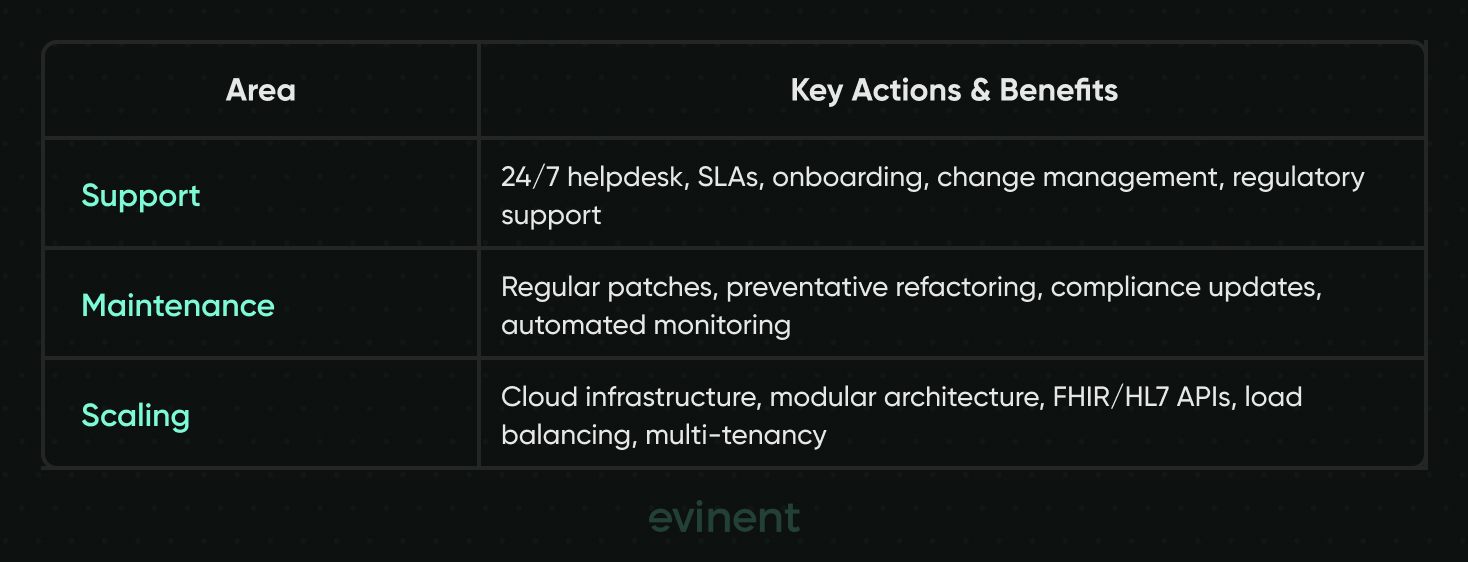
Technology Choices and Emerging Trends
The healthcare tech stack of 2025 is smarter, faster, and more predictive than ever — but it’s also under greater scrutiny. Balancing innovation with interoperability, compliance, and clinician usability is the new normal.
Cloud-First Architecture
Gone are the days of bulky, on-prem infrastructure. Today’s leading solutions run on cloud-native platforms like AWS, Azure for Healthcare, or Google Cloud, offering:
Auto-scaling for surging patient data
Built-in compliance with HIPAA and GDPR
Lower TCO via reduced infrastructure and maintenance costs
Faster deployment through containerized services and serverless functions
Modern healthcare products are increasingly modular, built using microservices and API-first logic, which makes them easier to evolve, integrate, and scale over time.
AI/ML and Predictive Analytics
In 2025, AI isn’t an add-on — it’s infrastructure.
Predictive analytics forecast patient deterioration or readmission risk before it happens
Diagnostic AI flags anomalies in radiology scans or pathology reports with clinician-grade accuracy
Large Language Models (LLMs) help physicians cut documentation time by 50% by auto-generating visit summaries and SOAP notes
AI chatbots guide patients through symptom checkers, post-op care instructions, and insurance pre-authorization
But with great power comes... complexity. Successful teams prioritize explainability, fairness, and clinical validation at every step.
Telehealth Is Now Healthcare
Virtual care is no longer just a COVID-era patch — it’s core to the hybrid care model.
Video visits, asynchronous messaging, and remote patient monitoring are foundational features
Hospital-at-home models are gaining traction for chronic care and post-discharge
Seamless integration with EHRs, billing, and appointment systems is critical to keep workflows intact
Expect telehealth platforms to evolve into full-fledged care coordination hubs, not just video call tools.
Blockchain for Medical Records
While not yet mainstream, blockchain technology is quietly reshaping:
Patient data integrity (via immutable audit trails)
Secure data sharing across providers and geographies
Consent management, letting patients control who accesses what, and when
It’s especially valuable in multi-stakeholder environments like clinical trials or distributed care networks.
FHIR APIs and Interoperability Standards
If your product can’t speak FHIR, it might be out of business.
Over 90% of health systems globally now deploy FHIR APIs for secure, standardized data exchange. Supporting HL7, DICOM, SNOMED CT, and LOINC isn’t optional — it’s how systems stay connected across labs, imaging centers, pharmacies, and clinics.
Bonus: AI-powered data harmonization tools are helping legacy platforms convert messy, outdated records into clean, usable formats.
The winners in 2025 aren’t just adopting flashy tech. They’re building healthcare platforms that are connected, secure, AI-smart, and human-centered — all while playing nicely with the messy, fragmented systems already in place.
Types of Healthcare Software Systems
Healthcare software in 2025 spans a wide range of tools built to improve care, streamline operations, and engage patients. Key categories include:
EHR/EMR Systems
Centralized platforms for managing patient histories, labs, prescriptions, and clinical workflows.
Telemedicine Platforms
Support virtual visits, remote monitoring, and secure communication — essential for hybrid care delivery.
Patient Portals & Engagement Tools
Allow patients to book appointments, access records, and message providers.
Medical Billing & RCM Software
Automate claims, insurance checks, and payments while staying compliant.
Practice & Hospital Management Systems
Handle scheduling, registration, inventory, and admin tasks in clinics and hospitals.
Clinical Decision Support (CDSS)
Offer AI-driven s and diagnostics to assist provider decision-making.
Remote Monitoring & IoMT Software
Track health data from wearables and devices in real time.
Healthcare CRM & Wellness Apps
Manage patient relationships, personalize care, and promote healthier lifestyles.
These systems work together to make care delivery more connected, efficient, and patient-centered.
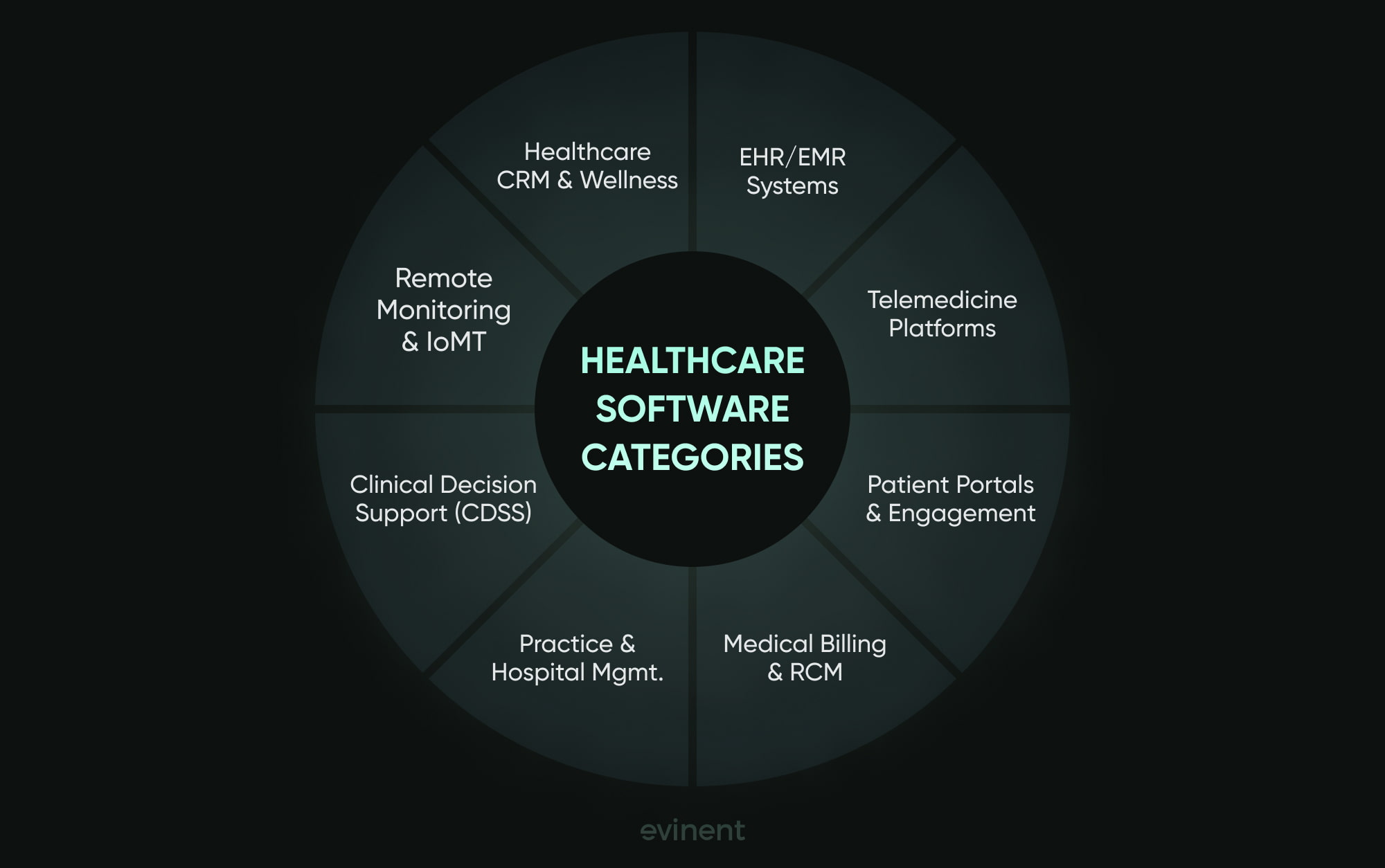
FAQ: Healthcare Software Product Development
What’s the fastest safe way to start?
Begin with a 2–4 week discovery: map regulations (HIPAA/GDPR/locals), define target FHIR resources (Patient, Encounter, Observation, MedicationRequest, Appointment), sketch a clickable prototype, and run a threat model. You leave with a scope, data flows, and a sprint-ready backlog.
Do we need FDA or MDR certification?
Only if your product qualifies as SaMD (software that drives diagnosis/treatment), expect risk management (ISO 14971), software lifecycle (IEC 62304), design controls, verification/validation, and post-market surveillance. If you’re not SaMD, focus on HIPAA/GDPR, SOC 2, or HITRUST, and solid QA.
What is PHI, and how do we handle it?
PHI = medical data plus any of HIPAA’s 18 identifiers (name, MRN, phone, etc.). Store only the minimum necessary data, encrypt it in transit (TLS) and at rest (e.g., AES-256), restrict access via RBAC/ABAC, and log every access/change.
How do we integrate with EHRs without breaking things?
Go FHIR-first with SMART/OAuth2, then bridge to HL7 v2 and DICOM where needed. Use an interface engine, standard terminologies (SNOMED CT, LOINC, RxNorm), and an identity-matching strategy. Monitor interfaces with health dashboards and retry queues.
What documents do auditors expect?
At minimum, the following documentation is required: data-flow diagrams, DPIA/TRA, traceability matrix, requirements/design controls, test reports, vulnerability scans/pen tests, SOPs, BAAs/DPAs, access reviews, and audit logs.
How much does it cost and how long will it take?
Typical ranges (feature + compliance dependent):
Basic medical utility: $30k–$75k, 3–6 months
Telemedicine platform: $30k–$300k, 8–15 months
Custom EHR module: $75k–$250k, 6–12 months
Enterprise EHR/hospital systems: $500k+, 12–18+ months
7. Where does AI fit and is it regulated?
Use AI for documentation help, triage cues, image pre-reads, risk scoring. If outputs directly influence diagnosis/treatment, you may be in SaMD scope; plan for explainability, bias testing, model change control, and clinical validation.
8. How do we measure ROI?
Track first-pass claim acceptance, denial rate, no-shows, time-to-note closure, care team throughput, readmissions, patient portal adoption, A/R days, and support ticket volume.
9. What team do we need?
Product manager, clinical SME, UX designer (accessibility-savvy), backend/frontend engineers, QA/automation, DevSecOps, and a security/compliance lead. For EHR work, add an interoperability engineer.
10. Do we need a BAA and consent tooling?
Yes, sign BAAs with any PHI-touching partner. Implement consent capture, scope-based access, and immutable audit logs (who saw what, when, why).
11. Post-launch: what’s non-negotiable?
24/7 monitoring, patch SLAs, quarterly access reviews, continuous compliance checks, and a data-quality playbook (terminology updates, mapping drift fixes).
How Evinent Can Help with Healthcare Software Product Development
At Evinent, we specialize in custom healthcare software development for enterprise and mid-sized organizations — especially those looking to modernize legacy systems or bring new digital health products to life.
If you're looking to outsource healthcare software development to a team that understands both clinical workflows and regulatory complexity, you're in the right place. We've delivered secure, intuitive platforms across the healthcare ecosystem — from EHR integrations and patient portals to cloud-native telehealth and IoMT solutions. Our engineers design for GDPR, and FDA compliance from day one — not as an afterthought.
What sets us apart?
We know how to modernize aging infrastructure without disrupting clinical operations. We build for scale — using AI/ML, cloud-native architecture, and modular APIs that future-proof your systems and improve your time-to-market.
Whether you're launching a new patient engagement tool, streamlining hospital operations, or migrating critical workflows to the cloud, we don’t just code — we architect, validate, and deliver healthcare platforms that are as resilient as they are innovative.
Let’s build something that saves lives — and actually works in the real world.
Conclusion — Key Takeaways
Start with the problem and the people. Co-design with clinicians and patients; map real workflows before code.
Compliance isn’t a gate; it’s daily work. Bake in HIPAA/GDPR, threat modeling, RBAC/ABAC, MFA, and audit logs from day one.
Interoperability is the plan. FHIR-first with bridges to HL7/DICOM and standard vocabularies (SNOMED/LOINC/RxNorm).
Security is the product. Encrypt everything, adopt zero-trust, monitor continuously, practice incident response.
Quality beats speed. Validate with clinicians, test integration paths, and track performance under real load.
Think TCO, not just MVP: Budget for maintenance, compliance updates, user training, and interface health.
Use data to prove value. Measure clinical and operational KPIs, not just feature counts.
Choose the right build model: Off-the-shelf for quick deployment; custom when workflows and scale matter.
Have a partner who knows health tech. Domain fluency and compliance experience shorten timelines and reduce risk.




